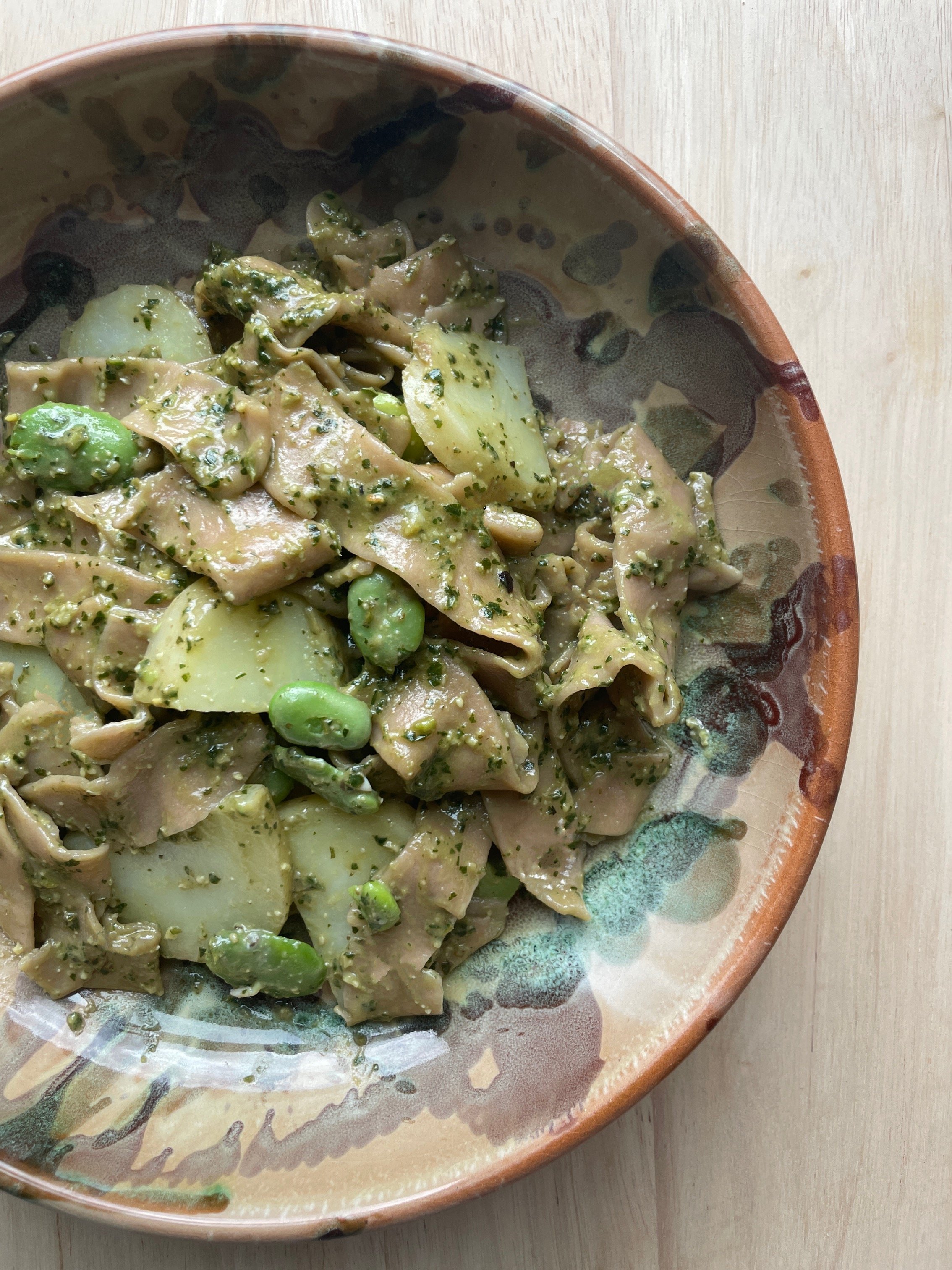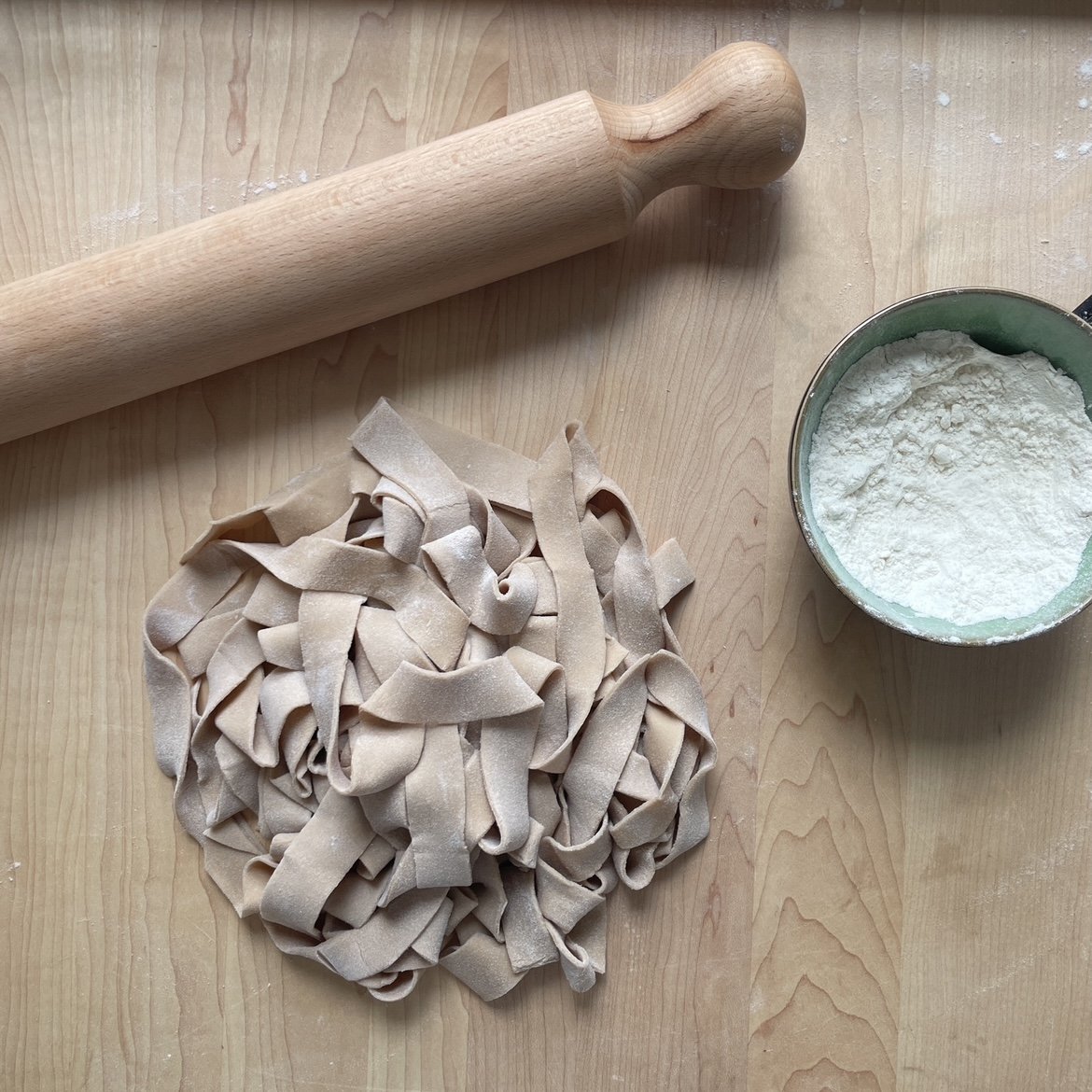Battolli di Uscio
My favorite way of discovering authentic pasta dishes remains the Pasta Grannies YouTube channel and Instagram. The videos are short and sweet, but still pack in incredible talent and generational knowledge.
I recently saw the video below, highlighting Antonietta from Uscio, a town in the hills of Liguria. I had been searching for dishes that star fava beans, as I recently found some at my local greengrocer and was itching to make them.
Antonietta made battolli, a long pasta that is part chestnut flour (which I had luckily brought back the last time I was in Italy!) and served them with pesto, fava beans, and potatoes.
Pesto is perhaps one of the most well known Italian condiments, especially the typical Genovese basil and pine nut version. Over recent years, others have grown in the international consciousness, from the raw tomato pesto alla Trapanese, to the sundried tomato pesto rosso, and the rich pesto di pistacchi. People are also embracing a variety of herbs, greens, and nuts.
The addition of potatoes and beans also grew in popularity internationally after the release of Pixar’s Luca, which featured trenette al pesto, a dish pairing trenette pasta with pesto alla Genovese, cubed potatoes, and cut string beans.
Needless to say, all kinds of pesto have been having their moment in the spotlight lately, and I was excited to develop another version, inspired by Antonietta’s own.
I kept the same main components - chesnut battolli, potato, fava beans, and basil pesto. However, I played around a bit with the pesto recipe, using ingredients I had on hand. Walnuts instead of pine nuts, and garlic confit instead of raw garlic (which I was excited to try, since I thought the sweetness would play well with the nuttiness of the chestnut flour).
While my recipe varies a bit from Antonietta’s, some research into battolli taught me that her version is only one of many. Battolli are sometimes made with egg in the dough, sometimes just water. Antonietta used fava as they were in season, but in winter, a local turnip is traditional. And most interestingly, while they are generally boiled in water, they are sometimes cooked in milk!
Before getting into the recipe, a note on chestnut flour -
I love working with “alternative” flours because they add color and flavor to my doughs. It is important to keep in mind, however, that when substituting in chestnut flour, or other low or no-gluten flours, for a portion of standard wheat flours, your dough will have a vastly different texture. Lower percentages of gluten in the flour means less gluten development from kneading, and so a less elastic dough to work with. These doughs are softer, will tear more easily, and are more fragile during cooking. It’s important to keep an eye on their hydration and treat them delicately when rolling, cutting, and boiling.
Ingredients
200g 00 flour
100g chestnut flour
150g water
60g basil leaves
30g walnuts
3 cloves garlic confit (if raw, only 1 clove)
50g Parmigiano Reggiano
75g olive oil
2 medium yellow potatoes
200g shelled fava beans
Start by making your pasta dough. Combine the two flours, pour them out on your work surface, make a well, and pour in the water. Combine and knead following the method shown here until your dough is cohesive and smooth. Cover tightly with plastic wrap and set aside to rest for at least thirty minutes.
Meanwhile, prepare your vegetables and the pesto. Wash and cut the potatoes into slices, as shown above. Next, shell the fava beans. Blanch both the potatoes and the fava beans, shocking both immediately after in cold water. Once the fave have cooled enough to touch, pop each bean out of the tough skin. Reserve both the potatoes and beans for later.
Next, make the pesto. In a food processor, or using a mortar and pestle if you have it, start by blending the garlic with the walnuts. Incorporate the basil next, then slowly stream in the olive oil. Finally, incorporate the cheese. Set aside in a large serving bowl for later.
I recommend rolling this dough out by hand, even if you have a pasta machine, as it is delicate and can easily tear. If you don’t have a long traditional mattarello, you can divide the dough in half or in thirds and use a shorter rolling pin.
While you bring your pasta water to a boil, roll the dough out to a few millimeters thick, rotating the disk every few passes to maintain as round a circle as possible. When you are satisfied with the thickness, fold the top half repeatedly onto itself down towards the middle, and then do the same with the bottom half, folding up to meet the top half. Cut into 1cm wide ribbons and shake out, keeping everything well floured.
Once the pasta water hits a roaring boil, lower the heat slightly and add in the battolli, stirring gently. Don’t allow the water to boil too violently, and don’t overcook the battolli, as the fragile pasta can break.
While the battolli cook, spoon a ladle of the starchy pasta water into the bowl holding the pesto, and mix to combine. Once ready, carefully drain the battolli and put directly into the bowl holding the pesto. Gently toss, adding in the potatoes and fava beans as well.
Serve with more Parmigiano Reggiano, if desired.











